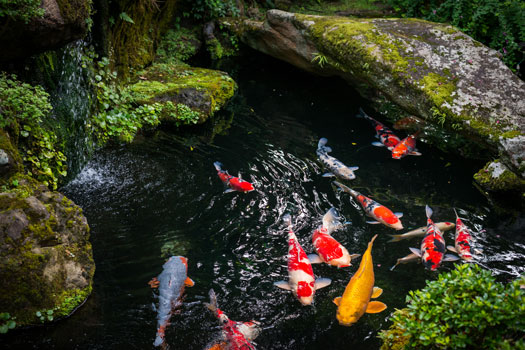- Your shopping cart is empty!
What Should a Koi Pond’s Water Quality Be Like?

With koi, you have a “fluid” situation that requires careful treatment of the pond water. The complexities of all that goes into the best water conditions may become overwhelming to first-time pond owners. With some knowledge and attention paid to water quality, anyone can tackle these challenges. To ease the stress on your fish from improper chemical balances, there are some crucial levels to watch for and correct when they get too high. The staff at Aquatic Warehouse, a leading provider of koi pond supplies, suggests the following.
The Level of Dissolved Oxygen
Water features such as fountains or waterfalls, along with temperature and vegetation all contribute to the level of dissolved oxygen in the water. Warm water or overcrowded ponds tend to deplete the level of dissolved oxygen. Ways for oxygen to become dissolved include the atmosphere, water breaking the water’s surface, and controlling the fish population. If your pond doesn’t have a waterfall feature running 24 hours a day, consider placing an air stone at the bottom of the pond. Ponds with a spout or fountain that sends the water into the air also dissolve oxygen.
Levels of Ammonia, Nitrites, and Nitrates
First of all, please buy a test kit so you know what’s happening with your pond! A test kit will tell you if you’re feeding too much or when to do a water change. Try to stay away from litmus test strips. An excellent option is a master test kit by API:
https://www.aquaticwarehouse.com/testing-/api-freshwater-master-test-kit
Koi excrete ammonia, which both oxygen and bacteria break down into nitrites. These eventually break down into nitrates and finally nitrogen. Here’s what to consider when it comes to these elements:
- Ammonia can burn the gills, limiting the ability to benefit from dissolved oxygen. The level of ammonia should be zero.
- Nitrites can do damage to the kidneys and nervous system. Keep this level below 0.25 ppm.
- Nitrates can compromise the immune system. Acceptable levels are between 10 and 50 ppm in a pond.
- Don’t forget to add live bacteria when you start a pond, and start with koi, not feeder goldfish that are infamous for bringing in a lot of diseases!
The Level of Salt
Using a small amount of salt in a koi pond can control algae, reduce the wrong types of bacteria, and even lower nitrite toxicity. Scientifically, the addition of salt to a freshwater fish pond reduces the physical effort the koi exert to swim around, which has to do with the osmotic pressure on the koi from the aquatic environment, though it may be hard on your aquatic plants, so find a happy medium. The salinity may be as much as 4 parts per thousand, or 0.5 percent. A simple refractometer can be used to test the water. Please don’t guess with this, as it’s very harmful to over-salt a koi pond.
Levels of Acids and Bases, or Pond pH
The levels of pH measuring the power of hydrogen should range between 6.8 and 8.2, keeping in mind that what seems like a small increase can amount to exponential increases for your koi’s health. You can affect the level of acid or alkaline by adding white vinegar or baking soda. Adding calcium carbonate to the pond is a good method for creating a long-term pH buffer. If you live in an acidic water area, look for agricultural limestone in the form of rocks or gravel you can add to your pond to avoid large swings.
The Water Temperature
Koi can handle wide-ranging water temperatures from 35 to 85 degrees Fahrenheit. However, warmer waters can make existing health problems much worse because the higher temperature means less dissolved oxygen while increasing ammonia toxicity. For the koi’s best health and comfort, the best range should stay within 65 and 75 degrees Fahrenheit while avoiding large temperature fluctuations.
If you need high-quality pond equipment to ensure you maintain a healthy koi pond environment, reach out to Aquatic Warehouse today. If you’re in San Diego, you can stop by our store in Kearny Mesa, or you can also check out our website or give us a call at 858-467-9297.
